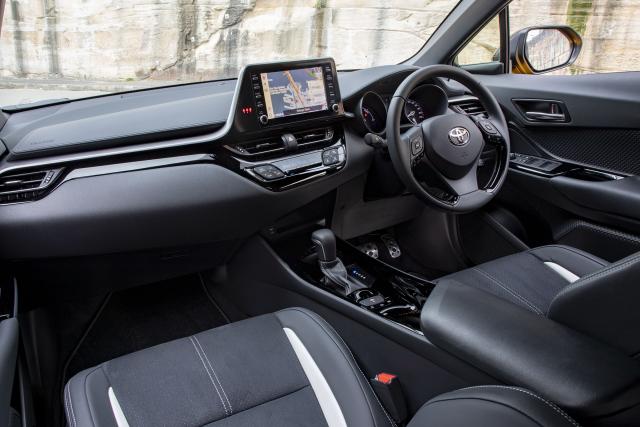The Toyota C-HR is a compact SUV that arrived here in 2016 when it filled the gap left by the RAV4 as that long-serving and popular model steadily grew in size into the mid-size vehicle that it is now.
Our test car was the top-spec C-HR GR Sport. The GR stands for Gazoo Racing, Toyota’s global motorsport division, but if you’re looking for a hot-hatch type SUV then you’re going to be disappointed.
Apart from some suspension tweaks and 19-inch alloy wheels the enhancements are largely cosmetic.
The complete C-HR range comes with two drivetrains, 1.2-litre naturally aspirated turbocharged petrol and 1.8-litre turbo petrol/ electric hybrid; three equipment levels, GXL, Koba and GR Sport; and either front- or all-wheel drive with the petrol-only models but only FWD with the hybrids.
STYLING
The C-HR, marks quite a change in styling from the relatively conservative looks that have worked so well for Toyota over the years. No doubt aimed at younger buyers.
The acronym C-HR stands for Coupe High Rider and this does describe its styling – a coupe-like upper body but with the reasonably high stance of an SUV.
The steeply sloped roofline tops off a lower body with plenty of creases and curves, especially around the rear.
‘Hidden’ rear door handles near the top of the C-pillar add to the coupe-like styling but can be a bit awkward to use.
Enhancements added to the GR Sport include bespoke two-tone 19-inch shadow chrome alloy wheels; a bold vertical grille split by a thick chrome horizontal bar; and new foglight surrounds.
There are GR Sport badges on the front, sides and rear as well as on the brake calipers.
INTERIOR
The sporty external theme is continued inside the C-HR GT Sport with dark silver highlights around the instrument panel and doors, piano black surrounds for the centre console and power-window switches.
Enhancements include GR Sport badging, leather accented sports seats and leather-wrapped steering wheel.
The rear seats are quite cramped although headroom is better than expected.
Children are not going to like the tall front seats and high tapered side windows which combine to seriously limit outward visibility.
There are no ventilation controls and no USB ports in the rear.
The boot has a 318-litre capacity. There are tie-down and carry hooks. The spare wheel is a space saver below the boot floor.
POWERTRAINS
C-HR comes with the choice of two powertrains.
There’s a 1.2-litre turbocharged petrol in the GXL and Koba variants, with either front- or all-wheel drive. Outputs are 85 kW and 185 Nm at 1500 rpm.
The Koba hybrid and C-HR GR Sport use a naturally aspirated 1.8-litre engine, with maximum power of 72 kW and 142 Nm of torque, with a 53 kW / 163 Nm electric for a combined power output of 90kW and an undisclosed amount of combined torque.
The 1.2-litre runs on standard unleaded petrol, the hybrid on premium.
Transmission is via continuously variable transmission although there is no manual mode in the hybrid variants.
SAFETY
Standard safety features across the C-HR range include seven airbags, enhanced ABS brakes with forward collision warning, brake assist and autonomous emergency braking, blind spot monitoring, road sign assist, rear cross traffic alert, hill-start assist, brake hold function and trailer sway control.
Koba (but not GR Sport) adds automatic braking to the rear cross traffic alert.
Also standard in all models is the Toyota Safety Sense package which adds lane trace assist, automatic high beam, active cruise control and pre-collision safety system with pedestrian detection.
INFOTAINMENT
Compared with the expansive wide screens which are becoming increasingly common in many vehicles the 8.0-inch touchscreen looks quite bland. However, infotainment screens are there to provide access to a
large number of functions without distracting the driver from the road ahead and we found the C-HR screen one of the easiest to use.
The screen is angled slightly towards the driver and within easy reach.
There are four rectangular short-cut buttons on each side of the screen that open up the various options on the screen itself.
Like many other embedded satellite navigation systems, the version in the C-HR is difficult to use with tiny symbols that don’t clearly indicate their functions. It’s hardly surprising that many drivers chose to use smartphone maps instead.
Bluetooth pairing is simple and allows access to Android Auto and Apple CarPlay, both wired, but no digital radio.
There’s 4.2-inch multi-information display in front of the driver with the usual features.
DRIVING
While the Toyota C-HR GR Sport talks the Gazoo Racing talk it certainly doesn’t walk the walk.
Unlike its GR Yaris, GR Supra and recently-launched GR86 there are no performance enhancements.
Of course, the other three are hatches or coupes while the C-HR is an SUV.
Having said that the C-HR is a capable and competent car to drive in normal day-to-day running.
It’s easy to manoeuvre around the suburbs and a cinch to park.
The option of all-wheel drive in the non-hybrid variants is a bit pointless with a ground clearance of just 137 mm effectively ruling out any off-road ventures.
Ride and handling in the GR Sport is excellent thanks to adjustments to the shock absorbers, spring rates and stabiliser bars. There’s also a new centre brace which improves body rigidity and contributes to a more direct steering response.
Toyota was one of the pioneers of petrol/electric hybrids and almost every vehicle in its large range has a hybrid option.
They have been refined the years and fuel consumption is a major selling point, never more so with soaring prices.
We were able to average 4.8 litres per 100 kilometres during our week-long test not that far above the claimed 4.3 L/100 km.
SUMMING UP
There’s plenty of competition in the sub-$40k compact SUV market segment where the C-HR sits mid-field behind the top-selling Mitsubishi ASX.
In addition to this rivalry with other brands, C-HR is certain to face a serious intra-brand challenge from the just-released Corolla Cross.
Both vehicles are built on the same platform but the Corolla Cross is marginally larger in all exterior dimensions.
The adventurous styling of the C-HR is likely to be one point of difference, especially with younger buyers.
We’re currently doing a review of the Corolla Cross shortly and will report back on what is likely to be a game-changer for the small SUV market.









